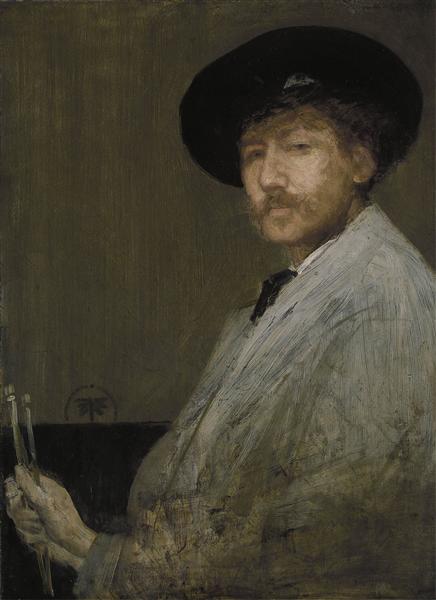Description
The painting "disposition in gray: portrait of the painter". This portrait is not only an excellent exponent of Whistler's aesthetic style, but also illustrates the evolution of his focus on artistic representation and his obsession with tone and form.
Whistler, an American artist who spent much of his career in Europe, was a pioneer in the search for visual harmony through a deliberate and controlled use of color and shape. In this portrait, use a gray palette that dominates the entire composition. The choice of color is not arbitrary; Gray, in its multiple nuances, creates an atmosphere of serenity and reflection, allowing the observer to concentrate on the figure of the painter without chromatic distractions. This monochromatic approach is a distinctive seal of Whistler's work, whose philosophy was that "painting should be as musical as a symphony."
As for the artistic composition, Whistler stands standing, elegantly dressed in a black coat that suits harmoniously with the background of gray and black tones. Its pose is relaxed, but the posture denotes a certain dignity and self -affirmation. He holds a palette and a brush, emblematic tools of his trade, suggesting his artistic identity without the need for extravagant details. This minimalist representation is a testimony of Whistler's artistic creed: beauty resides in the simplicity and purity of form.
The background of the paint is equally significant. Whistler has opted for an almost abstract background, without unnecessary details that can steal prominence to the central figure. This choice highlights its approach to the balance and the unit of composition. The absence of a defined environment also gives a sensation of temporal and spatial indefinition, placing the painter in an almost ethereal space that transcends ordinary reality.
In addition, the work belongs to a series of portraits and compositions that Whistler called "arrangements" (arrangements), where he was looking for correlations between painting and music, pretending that the visual work resonated with the same harmony and structure as a musical composition.
Historically, this painting is in a transition period for Whistler, who began to distance himself from the influences of realism and impressionism to develop his own aesthetic language. The choice of the English title "Arrangement in Gray" underlines its approach to a controlled and meticulous composition, where each element has a precise purpose in the entire work.
Although less known than his famous "portrait of the artist's mother" (1871), this "gray disposition: portrait of the painter" offers an intimate vision of the artist not only as a creator, but also as a subject worthy of contemplation. The work provides a poetic introspection in Whistler's artistic identity, raising issues about self-representation and art as an extension of being.
In conclusion, "Gray disposition: Painter portrait" is a core piece to understand the stylistic and philosophical evolution of James McNeill Whistler. Its subtle use of gray tones, its masterful composition and introspective representation of the painter make this work a lasting testimony of their artistic genius. This painting He continues to invite spectators to immerse themselves in a deep contemplation, revealing the nuances of the painter's soul through monochrome and careful composition.
KUADROS ©, a famous paint on your wall.
Hand-made oil painting reproductions, with the quality of professional artists and the distinctive seal of KUADROS ©.
Art reproduction service with satisfaction guarantee. If you are not completely satisfied with the replica of your painting, we refund your money 100%.

